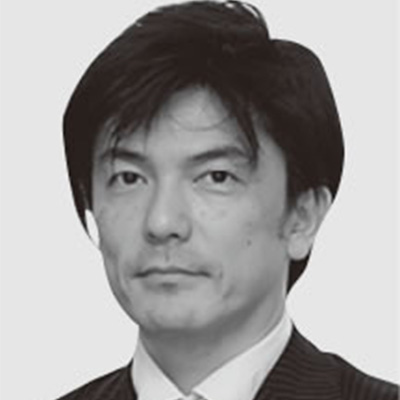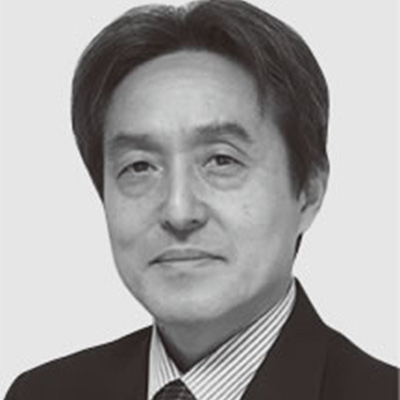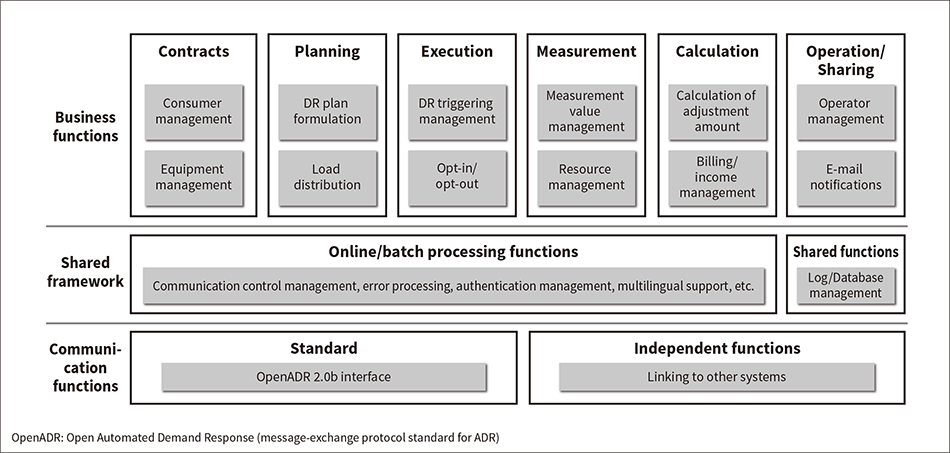As progress is being made worldwide in countermeasures against global warming, methods of supplying one of the most important parts of social infrastructure, energy, differ between nations and regions, and solutions for the increasingly diverse problems and needs of society are in demand. Hitachi is working to develop technologies, including energy management technologies, that can save energy in urban areas and provide a stable supply of energy even during disasters, as well as technologies utilizing storage batteries that can contribute to the promotion of renewable energy use in island regions. In addition, Hitachi is contributing to the development of solutions to the challenges facing customers and society as a whole with technologies such as microgrids, and DR and VPP technologies that can support domestic power system reforms.

Project Promotion Department, Power System Information & Controls Business Division, Energy Solutions Business Unit, Hitachi, Ltd. Current work and research: Energy solution business.

Service Technology Center, Total Engineering Division 1, Social Innovation Business Division, Hitachi, Ltd. Current work and research: Design and development of energy-related services and solutions. Society memberships: The Society of Heating, Air-Conditioning and Sanitary Engineers of Japan (SHASE).

Project Promotion Department, Power System Information & Controls Business Division, Energy Solutions Business Unit, Hitachi, Ltd. Current work and research: Business development of energy solutions.

Demand Side Management Solution Department, Power System Information & Controls Business Division, Energy Solutions Business Unit, Hitachi, Ltd. Current work and research: Promotion, design, and development of energy-related services and solutions.

Energy Management Systems Research Department, Center for Technology Innovation — Energy, Research & Development Group, Hitachi, Ltd. Current work and research: Research and development of energy solutions.
The amount of energy consumed in the world has been growing continuously at an average annual rate of 2.6% since 1965(1). An examination of the breakdown of energy consumption by region shows that, although the growth rate is pronounced in developing economies with significant expansions in both population and economy, the increase in energy consumption amounts has slowed in developed economies. This is partially due to the influence of efforts to conserve energy and reduce carbon emissions.
The circumstances behind energy differ widely depending on the country, region, industry, and other factors, and the priorities for functions and performance demanded for the energy infrastructure also differ. This article presents case studies of Hitachi’s energy solutions that are meeting the increasingly diverse energy challenges and needs of society, and describes the expected future developments.
Global efforts to reduce greenhouse gas emissions are moving forward with the adoption and enforcement of the Paris Agreement at the Twenty-first Conference of Parties (COP21) of the United Nations Framework Convention on Climate Change. As the movement toward energy conservation and consideration for the environment gathers momentum in developed economies, especially in urban areas, reasonable countermeasures that do not sacrifice comfort or convenience have become necessary. Furthermore, energy supply systems that will allow social activity and business operations to continue even during typhoons, earthquakes, and other disasters are also needed.
As previously constructed energy infrastructures continue to deteriorate, developed economies are faced with the challenge of reducing the cost of updating and strengthening infrastructure equipment.
On the other hand, the level of energy consumption is increasing dramatically in developing economies on an annual basis as their populations and economies expand rapidly. For this reason, the energy demand exceeds supply capacity in some regions, and although energy infrastructures are being built quickly, challenges remain including cost and finding a way to conserve the natural environment while providing the required energy. Furthermore, although fossil fuels have been the main source of power in island regions in the past, the utilization of wind, solar, and other forms of renewable energy that take advantage of island climates is expected to lower the cost of power generation by reducing fuel costs while contributing to a reduction in CO2 at the same time.
With the full liberalization of the retail energy market implemented in 2016, and the legal unbundling of the transmission and distribution sector planned for 2020, power system reforms are moving forward in Japan. In addition to traditional power companies, a variety of companies from different industries, including gas, oil, communication, and retail companies, will be given new business opportunities. Although different companies face different business challenges, they will all need to respond to the evolving energy infrastructure and market while building mutual relationships.
The rest of this article discusses Hitachi’s energy solutions for flexibly responding to these increasingly diverse challenges and needs.
In addition to reductions in CO2 emissions through the promotion of energy conservation, urban areas also require energy supply systems that are robust enough to withstand disasters and other problems. This section describes Hitachi’s energy solutions that respond to these challenges by efficiently managing and operating heat and power over an entire region, using case studies of the northern district of the East Entrance of Tamachi Station in Tokyo, and Kashiwa-no-ha Smart City, located in Kashiwa City, Chiba Prefecture.
In the northern district of the East Entrance of Tamachi Station (Minato City, Tokyo), a smart energy network for controlling energy usage and unused energy throughout the area was established based on the “Vision for city development in the northern district of the East Entrance of Tamachi Station” (October 2007) in a public-private cooperation project, including Minato City, Aiiku Hospital, Tokyo Gas Engineering Solutions Corporation, and Tokyo Gas Co., Ltd. This eco-conscious and disaster-resistant city aims to reduce CO2 emissions to 45% below 1990 levels (see Figure 1).
Hitachi provided an optimizing supply-demand control system for heat supply for the district heating and cooling business operated by Tokyo Gas Engineering Solutions Corporation. The system combines information from buildings demanding heat and from the 1st Smart Energy Center which supplies heat, based on information and communication technology (ICT), enabling centralized management and control of the supply and demand of energy. By forecasting future heat demand (see Figure 2) from past operation record data and weather forecast data based on memory-based reasoning (MBR) and assessing the outside temperature/humidity, energy usage by air-conditioners, etc. in buildings, and operating conditions of heat-source systems, this system allows the 1st Smart Energy Center to optimally control the temperature, pressure, and other settings of air-conditioners and heat-source systems in real time to reduce carbon emissions in the entire area(2), (3).
Figure 1 — Heat Supply Project in the Northern District of the East Entrance of Tamachi Station (from the Tokyo Gas Co., Ltd. Website)
 This heat, power, and information network was constructed in order to implement optimized operation and control by coordinating the demand and the supply sides, thereby realizing urban development with lower CO2 emissions enabled by a smart energy network that represents the evolution of traditional regional heat supply systems. In recognition of the innovative spirit of this effort, the Ministry of Land, Infrastructure, Transport and Tourism selected the project as a “Pilot Enterprise in Low-CO2 Residences and Buildings” (https://eee.tokyo-gas.co.jp/sen/case/case04.html, in Japanese).
This heat, power, and information network was constructed in order to implement optimized operation and control by coordinating the demand and the supply sides, thereby realizing urban development with lower CO2 emissions enabled by a smart energy network that represents the evolution of traditional regional heat supply systems. In recognition of the innovative spirit of this effort, the Ministry of Land, Infrastructure, Transport and Tourism selected the project as a “Pilot Enterprise in Low-CO2 Residences and Buildings” (https://eee.tokyo-gas.co.jp/sen/case/case04.html, in Japanese).
Figure 2 — Heat Demand Prediction Concept Based on MBR
 By extracting past weather result values and heat result values and comparing them to similar future weather forecasting values (temperature, humidity, and so on), this system estimates future heat demand values from weighted averages of heat demand results based on the distances between weather forecasting values and result values in the data.
By extracting past weather result values and heat result values and comparing them to similar future weather forecasting values (temperature, humidity, and so on), this system estimates future heat demand values from weighted averages of heat demand results based on the distances between weather forecasting values and result values in the data.
Based on the concept of “An Urban Model for Our Future” aimed at using urban development to solve the world’s problems, Kashiwa-no-ha Campus (Kashiwa City, Chiba Prefecture) promotes the three themes of environmental symbiosis, health and longevity, and the creation of new industries. Efforts toward environmental symbiosis (energy) include the construction of energy management systems that manage energy over an entire region, including the creation, storage, and conservation of energy, energy conservation with the participation of citizens, reducing carbon emissions across the entire region, and urban development that can withstand disasters (see Figure 3).
In addition to the Kashiwa-no-ha Area Energy Management System (AEMS) that acts as the brain, Hitachi also provides 3.8 MWh lithium-ion battery systems, power transmission systems, and other equipment. The AEMS integrates the distributed power sources for each city block or building as well as independently maintained local information and power networks between the building energy management systems (BEMS) and home energy management systems (HEMS) of buildings and residences, thereby providing centralized control based on energy information collected from facilities throughout the entire region, including information on power (receiving, generating, and demand statuses), gas, water, and so on. The system estimates energy demand by analyzing this information in order to efficiently run the entire city and reduce carbon emissions.
Independent power lines with a total length of 2,500 m extend from the energy facility to the surrounding city blocks. To level out the power of the entire city, with each facility receiving power separately from the power company, storage battery power sent through the independent lines is interchanged between city blocks to implement peak cuts for each facility in the first domestic power interchange system ever constructed.
The AEMS also has monitoring and guidance functions for use during disasters and other emergency situations, and can provide condominium complexes, research facilities, and other buildings with the minimum power supply load necessary (for emergency elevators, lighting for communal areas, power outlets, mechanized parking lots, assembly halls, etc.) when a power outage occurs in the region.
In addition, the AEMS uses tablet information terminals to provide information to residents and tenant users regarding the status of the energy supply and demand in the region, energy conservation advice, and other information. Energy information is also distributed to web portals and digital signage through regional information networks and the Internet.
As described above, the Kashiwa-no-ha campus is an advanced case study of an energy solution project that uses the energy infrastructure to add value for a city.
Figure 3 — Overview of Kashiwa-no-ha Campus, Kashiwa-no-ha Smart City
 Kashiwa-no-ha Smart City collects and manages energy usage amounts in a unified fashion, and predicts energy demand while running the entire area efficiently. It also supplies the minimum necessary power when an outage occurs due to a disaster or other reason.
Kashiwa-no-ha Smart City collects and manages energy usage amounts in a unified fashion, and predicts energy demand while running the entire area efficiently. It also supplies the minimum necessary power when an outage occurs due to a disaster or other reason.
In island regions, there is a need to reduce fuel costs and other power generation costs by cutting back on power generation with fossil fuels, thereby contributing to a reduction in CO2 emissions. This section introduces case studies in Hawaii in the USA and on Izu Oshima Island in Tokyo describing Hitachi’s energy solutions designed to resolve this challenge by utilizing storage batteries to enable expanded use of renewable energy.
The State of Hawaii, USA has legislated a plan to meet at least 40% of its power demand with renewable energy by the year 2030. The island of Maui, where the use of renewable energy has already expanded a great deal, had already achieved approximately 30% of its total power generation using renewable energy as of March 2014. The need to maintain power quality is a challenge that must be faced in order to increase the ratio of wind and solar power generation, from which the power output is unstable. In order to meet this challenge, Hitachi commenced the Japan-U.S. Island Grid Project (smart grid demonstration project name: JUMPSmartMaui) in December 2013 on the island of Maui in a joint project with the New Energy and Industrial Technology Development Organization (NEDO).
Due to the installation of large amounts of solar power generation capacity, the amount of solar power generated during the day sometimes exceeds demand, and other than the amount of power needed for the stable operation of power grids, traditional power supplies such as thermal generators sometimes do not need to operate. On the other hand, the amount of solar power generated at sunset and throughout the night decreases dramatically while the demand for power in homes skyrockets, so traditional power sources must supply large amounts of power within a short period. For this reason, it is necessary to continue operating traditional power sources in standby mode during the day, even during timeframes where they otherwise would not be needed. This has led to a new problem of decreased efficiency caused by the suppression of solar power output and standby operation of traditional power sources during the day.
To deal with this kind of problem, Hitachi currently takes electric vehicle (EV) storage batteries, which are subject to demand response (DR), and utilizes them for their “Posiwatt, vehicle to grid (V2G)” effect, to discharge electricity from the storage battery to the grid, in addition to their “Negawatt” effect via charge cutoff. In addition, Hitachi aggregates distributed EV storage batteries and controls them all with virtual power plant (VPP) technology in a project to evaluate effectiveness with the voluntary participation of a total of 83 ordinary households and business volunteers (see Figure 4).
By verifying the effectiveness of solutions utilizing EV storage batteries that can discharge as well as recharge power, and aggregating energy resources, Hitachi is working to help accelerate the introduction of renewable energy.
Figure 4 — System Configuration Diagram
 The system is comprised of home gateways that can shut off ordinary EV chargers and water heaters in the home, Smart PCS units that can control solar power output, home-use storage batteries, 13 EV fast-charging stations on the island, and a μ-DMS that can control these devices by individual low-voltage transformer. Power supply and demand balance is optimized for the entire island with storage batteries on the grid side and distributed power sources on the island with a DMS used for integrated management.
The system is comprised of home gateways that can shut off ordinary EV chargers and water heaters in the home, Smart PCS units that can control solar power output, home-use storage batteries, 13 EV fast-charging stations on the island, and a μ-DMS that can control these devices by individual low-voltage transformer. Power supply and demand balance is optimized for the entire island with storage batteries on the grid side and distributed power sources on the island with a DMS used for integrated management.
Since the amount of power generated by renewable energy fluctuates depending on the weather, surplus power can be generated, which poses a challenge because it can affect the voltage or frequency of the grid. This is particularly a challenge in island regions because their grids are small-scale and independent, and fluctuations in the output of renewable energy can have pronounced effects on their grids.
Taking solar power generation as an example, there can be long-term output fluctuations depending on the time of day (morning, noon, and night), along with short-term output fluctuations due to clouds blocking the sunlight. Focusing on these two types of output fluctuations as factors that affect grids, Hitachi is proposing the hybrid battery energy storage system, which combines different types of storage batteries as countermeasures for both types of fluctuations.
Hitachi, Ltd. and Hitachi Chemical Co., Ltd. worked together to develop the 1.5-MW hybrid battery energy storage system, which combines lead-acid batteries that have high-capacity “endurance” with lithium-ion capacitors that can respond to sharp fluctuations of up to several hundred milliseconds with “instantaneous power” (see Figure 5). As part of the NEDO-subsidized “Development of Safe, Low-cost Large-scale Hybrid Power Storage System Technologies” project that ran from 2011 to February 2016, Hitachi connected this system to the Izu Oshima Island (Tokyo) grid and conducted a demonstration experiment with the cooperation of TEPCO Power Grid, Inc.
As a result, governor-free operation of the storage batteries reduced frequency fluctuations in the grid, and the experiment confirmed that this contributes to grid stabilization (see Figure 6). There are also prospects for reducing power generation costs by using peak shift operation with storage batteries to reduce the number of existing diesel power generators that must be used, and by enabling reduced running times with power generators using a load factor with a low power generation efficiency(4).
Hitachi is currently engaged in joint research with TEPCO Power Grid, and plans to conduct more detailed evaluation and verification work, to be followed by practical application of the technology.
Figure 5 — Hybrid Storage Batteries on Izu Oshima Island
 The 1.5-MW Hybrid Battery Energy Storage System combines lead-acid batteries that have high-capacity “endurance” with lithium-ion capacitors that have “instantaneous power” and can suppress both long-term and short-term fluctuations.
The 1.5-MW Hybrid Battery Energy Storage System combines lead-acid batteries that have high-capacity “endurance” with lithium-ion capacitors that have “instantaneous power” and can suppress both long-term and short-term fluctuations.
Figure 6 — Example of Results of Suppressing Frequency Fluctuations with Hybrid Battery Energy Storage System (Two Hours of Measurements with and without Control)
 Hitachi confirmed that the use of a storage system with governor-free control reduces frequency fluctuations and can contribute to grid stabilization.
Hitachi confirmed that the use of a storage system with governor-free control reduces frequency fluctuations and can contribute to grid stabilization.
By utilizing the technologies described above, Hitachi is planning to combine the experience and know-how it has built up regarding the manufacture and operation of energy equipment with information technology (IT) in order to develop the following new solutions.
Major power outages have been increasing recently in North America due to the effects of deteriorating power infrastructures and natural disasters. Also, low-level price stability in gas prices resulting from the shale gas revolution has contributed to an increasing need for microgrids that combine high resiliency with economic efficiency.
Since microgrids aggregate solar power generation and other types of renewable energy, power generators, storage batteries, refrigerators, heat storage tanks and other types of heat-source systems, and consumer load, they can reduce CO2 emissions by optimizing the supply and demand balance of both power and heat while minimizing operating costs at the same time. Hitachi has developed technology to prevent reverse power flow while securing power quality when a microgrid is connected to a power grid, and has verified the effectiveness of this technology at the EXPO 2005 AICHI, JAPAN (the 2005 World Exposition, Aichi, Japan) and in the NEDO Sendai Microgrid Project(5). Also, by integrating the energy management and the technologies utilizing storage batteries described in the third and fourth sections of this article, Hitachi is currently working to deploy microgrid solutions at university campuses, shopping malls, municipalities, and other locations in North America.
As microgrids continue to spread in the future, it is expected that, not only will they be optimized internally, but that the interchange of power between multiple microgrids that are connected to power grids will improve energy efficiency in entire regions (see Figure 7). For instance, when the constitution of the types of industries consumers are engaged in varies, this is expected to result in a different power and heat demand pattern. In this case, if surplus power is generated by a microgrid, it can be interchanged to a microgrid that is not generating enough power to further improve the energy efficiency of the whole.
This is why Hitachi developed heat and power operation planning technology that can link multiple microgrids in order to manage and operate them in an integrated fashion(6). In the past, since heat and power were optimized within individual microgrids, there was sometimes surplus solar power generated, or it was sometimes necessary to purchase expensive external power when there was excess heat from the cogeneration system. By managing and operating multiple microgrids in an integrated fashion, the area energy management system (AEMS) coordinates with the energy management system (EMS) installed on each microgrid, considers the heat and power demands within each microgrid, and interchanges power between each microgrid in order to minimize cogeneration waste heat as a whole while maximizing energy efficiency throughout the entire area (see Figure 8).
In addition, surplus power transactions in the power market have begun in North America, so further improvements in both energy and economic efficiency are expected to be achieved by aggregating the surplus power of multiple microgrids.
In the future, microgrids will also take on the role of contributing to the stabilization of voltage and frequency fluctuations in grids that can arise due to the introduction of renewable energy, thereby providing new value.
Furthermore, Hitachi will achieve scalability by using standard international communication protocols to make communication with utilities and other microgrid management systems easy. It will also develop flexible microgrid solutions with a high level of added value from a single microgrid to coordinate with multiple microgrids over a wide area, as well as by linking with power markets and providing other services.
As the domestic Japanese power system reforms continue, a Negawatt market will be established in 2017, followed by a real-time market in 2019. Also, in addition to the design of systems to provide adjustability, the creation of an energy aggregation business is also expected(7) (see Figure 9).
Hitachi has verified the effectiveness of its solutions in power generation, transmission and distribution, and retailing with the aforementioned smart grid demonstration project in Hawaii, the hybrid battery energy storage system on Izu Oshima Island, the Smart Community Project in Greater Manchester, UK (implemented by NEDO)(8), and in other areas (see Figure 10). Hitachi will respond flexibly to this new energy market by making the most of the operational technology (OT) it has acquired relating to the operation and control of energy equipment, and the IT it has acquired relating to the analysis and utilization of data.
Furthermore, Hitachi will continue working to resolve the business challenges of each stakeholder in the value chain based on its Internet of Things platform Lumada(9), which combines technologies such as big data analysis technology, artificial intelligence, and analytics using Pentaho software(10).
Figure 9 — Example of Configuration of Virtual Power Plant Management System Functions
 A virtual power plant management system in the aggregation business consists of business functions, from contracts to operations, implemented on a shared framework along with communication functions based on a standard.
A virtual power plant management system in the aggregation business consists of business functions, from contracts to operations, implemented on a shared framework along with communication functions based on a standard.
The challenges and needs related to energy, which vary depending on the country and the region, and for each stakeholder in terms of both supply and demand, are growing increasingly complicated and diverse.
Hitachi will continue working with customers as it flexibly combines the experience and know-how it has built up regarding the manufacture of energy equipment with IT and OT in order to accelerate the creation of solutions to these challenges.